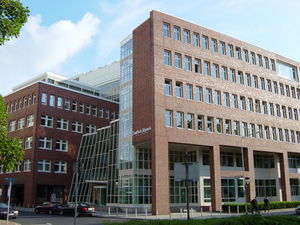Frankfurter Allgemeine Zeitung
|
|
|
| Type | Daily newspaper |
|---|---|
| Format | Broadsheet |
| Owner | Fazit-Stiftung |
| Editor | Werner D'Inka Berthold Kohler Günther Nonnenmacher Frank Schirrmacher Holger Steltzner |
| Founded | 1 november 1949 |
| Political alignment | conservative |
| Headquarters | Frankfurt |
| Official website | faz.net |

The Frankfurter Allgemeine Zeitung (English literally Frankfurt General Newspaper), short F.A.Z., also known as the FAZ, is a national German newspaper, founded in 1949. It is published daily in Frankfurt am Main. The Sunday edition is the Frankfurter Allgemeine Sonntagszeitung (F.A.S.). F.A.Z. has a circulation of 366,844 (3rd quarter 2008)[1] and has a slight centre-right or conservative bias.
The F.A.Z. has the legal form of a GmbH. The independent FAZIT-Stiftung (FAZIT Foundation) is its majority shareholder. About 40 percent of its shares are held by the company itself.[2] The F.A.Z. runs its own correspondent network. Its editorial policy is not determined by a single editor, but cooperatively by five editors. It is the German newspaper with the widest circulation abroad, with its editors claiming to deliver the newspaper to 148 countries every day.
Contents |
History
The first edition of the F.A.Z. appeared on November 1, 1949; its founding editor was Erich Welter. Some editors had worked for the Frankfurter Zeitung, which was banned in 1943.
Traditionally, many of the headlines in the F.A.Z. were styled in orthodox blackletter format and no photographs appeared on the title page. Some of the rare exceptions were a picture of the celebrating people in front of the Reichstag in Berlin on the German Unity Day on 4 October 1990, and the two pictures in the edition of 12 September 2001 showing the collapsing World Trade Center and the American president George W. Bush. Since October 5, 2007, the F.A.Z. altered their traditional layout to include color photographs on the front page and exclude blackletter typeface outside the masthead.
Currently, the F.A.Z. is produced electronically using the Networked Interactive Content Access (NICA) and Hermes. For its characteristic comment headings, a digital Fraktur font was ordered. The Fraktur has since been abandoned, however, with the above-mentioned change of layout. After introducing on August 1, 1999, the new spelling prescribed by the German spelling reform of 1996, the F.A.Z. returned exactly one year later to the old spelling, declaring that their experience had shown that the reform was ambiguous and partly nonsensical. After several changes had been made to the new spelling, F.A.Z. accepted it and started using it (in a custom version) on January 1, 2007. Due to its traditionally sober layout, the introduction of colour photographs in the F.A.Z. was controversially discussed by the readers.
Profile
The F.A.Z. is one of a small number of high-profile national newspapers in Germany (along with its closest competitors, the Süddeutsche Zeitung, Die Welt and the Frankfurter Rundschau). It maintains the largest number of foreign correspondents of any European newspaper (53 as of 2002)[3].
The F.A.Z. promotes an image of making its readers think. The truth is stated to be sacred to the F.A.Z., so care is taken to clearly label news reports and comments as such. Its political orientation is classical liberal with an occasional support for conservative views by providing a forum to commentators with different opinions. In particular, the feuilleton and some sections of the Sunday edition cannot be said to be specifically conservative or liberal at all.
Famous contributors
- Patrick Bahners
- Hans Dietmar Barbier
- Dietmar Dath
- Karl Feldmeier
- Joachim Fest (former editor)
- Karl Friedrich Fromme (former editor)
- Greser&Lenz
- Georg Paul Hefty
- Florian Illies
- Daniel Kehlmann
- Ernst Nolte
- Andreas Platthaus
- Marcel Reich-Ranicki
- Volker Reiche (see Strizz)
- Frank Schirrmacher
External links
- The F.A.Z. online edition (in German; most articles are free)
- Explanation for the return to the pre-reform spelling (in German)
- Ketupa.net - Frankfurter Zeitung and F.A.Z. media profile
References
- ↑ "F.A.Z. und F.A.S. gewinnen Auflage". Frankfurter Allgemeine Zeitung, October 16, 2008, page 16.
- ↑ Hamann, Götz (2007-09-20). "Sparen, bis die Leser gehen?" (in German). Die Zeit. http://www.zeit.de/2007/39/zukunft-der-zeitung. Retrieved 2008-07-31.
- ↑ Hans Magnus Enzensberger: Die geschrumpfte Welt auf Zeitungspapier. In: FAZ, 7. März 2002